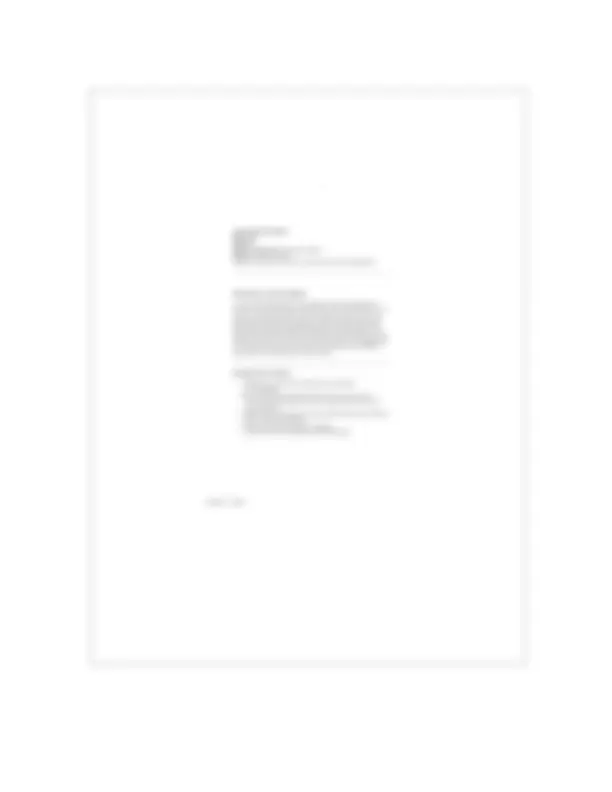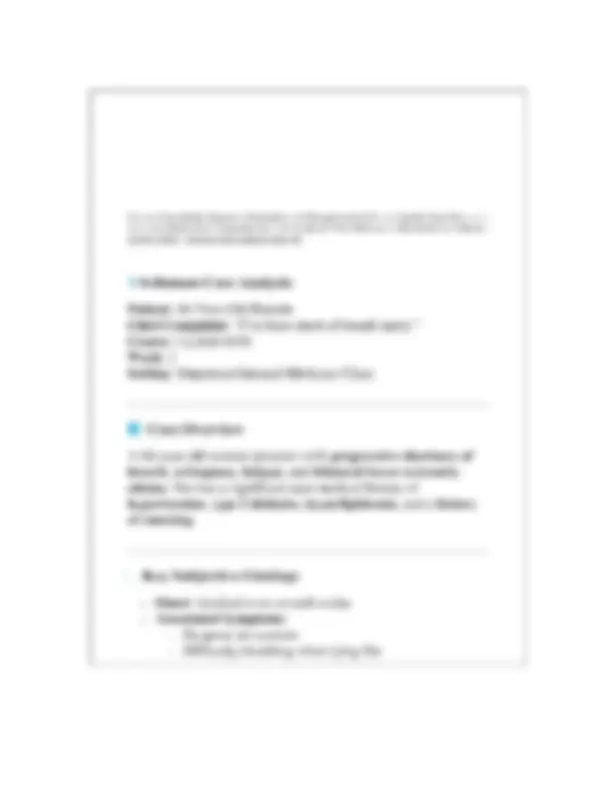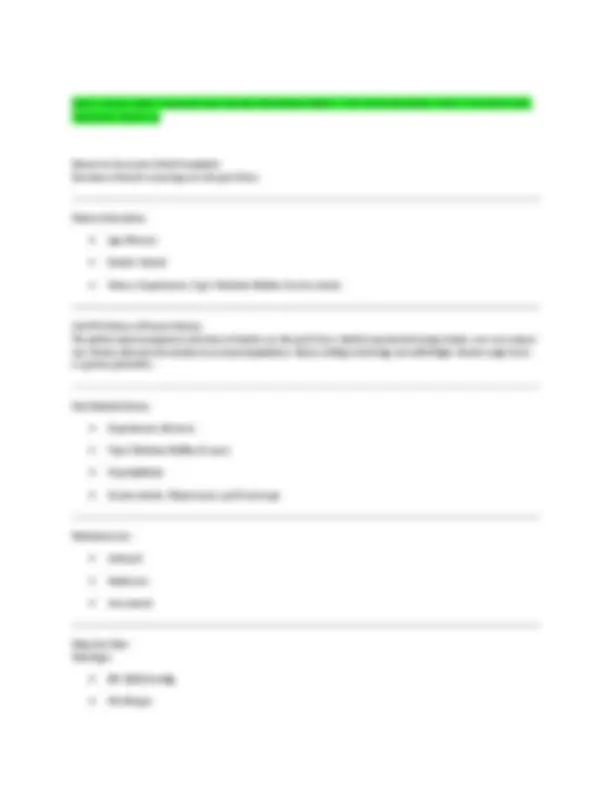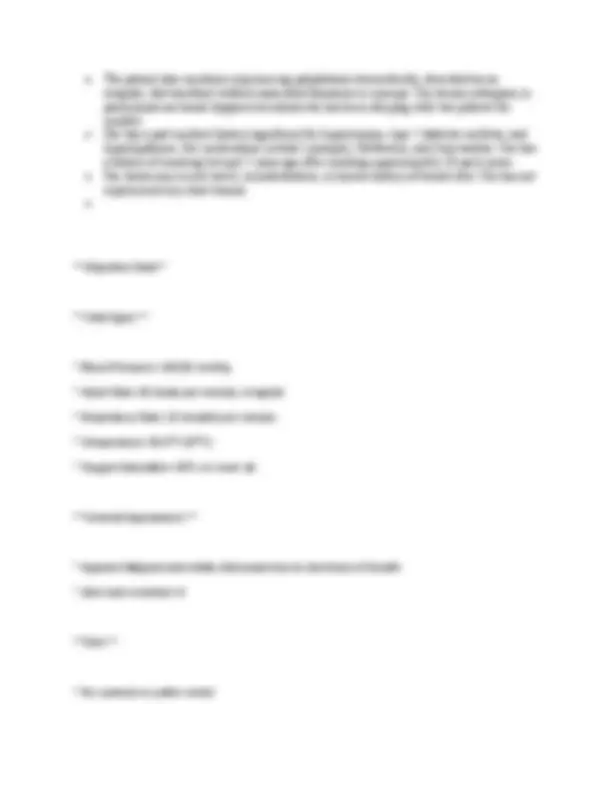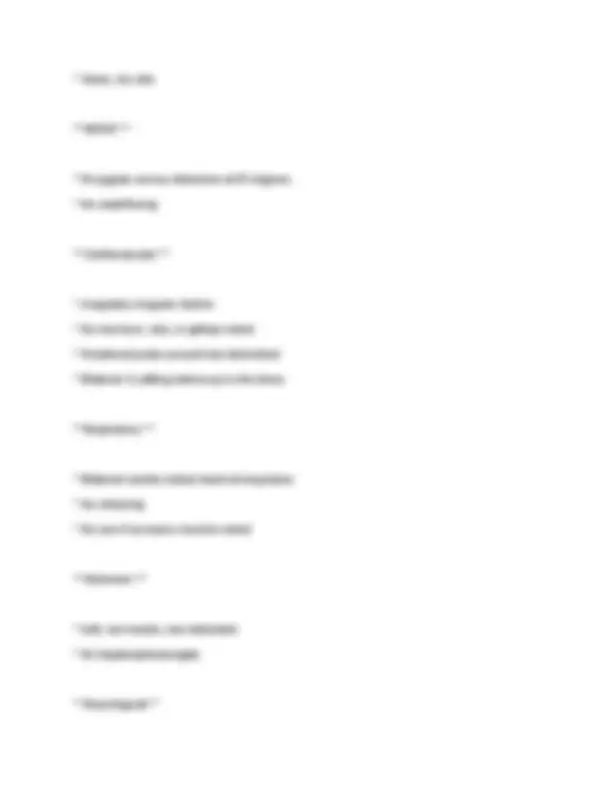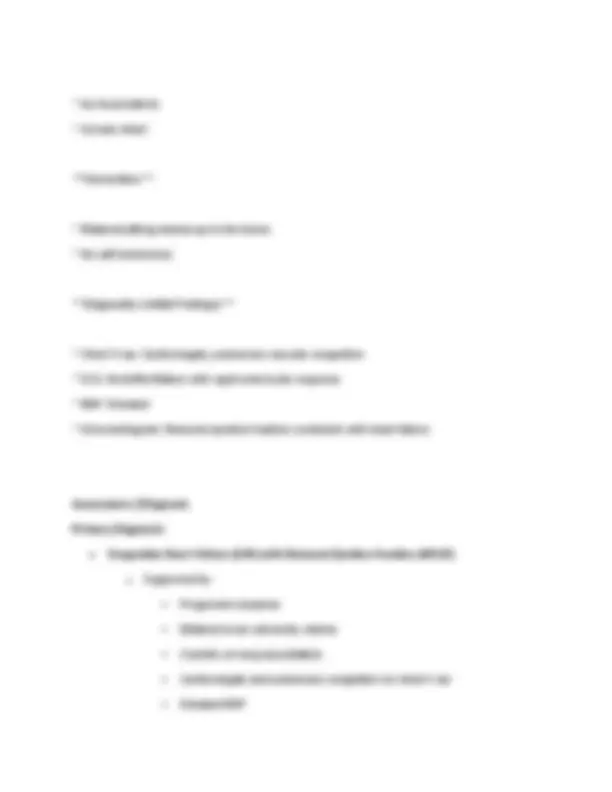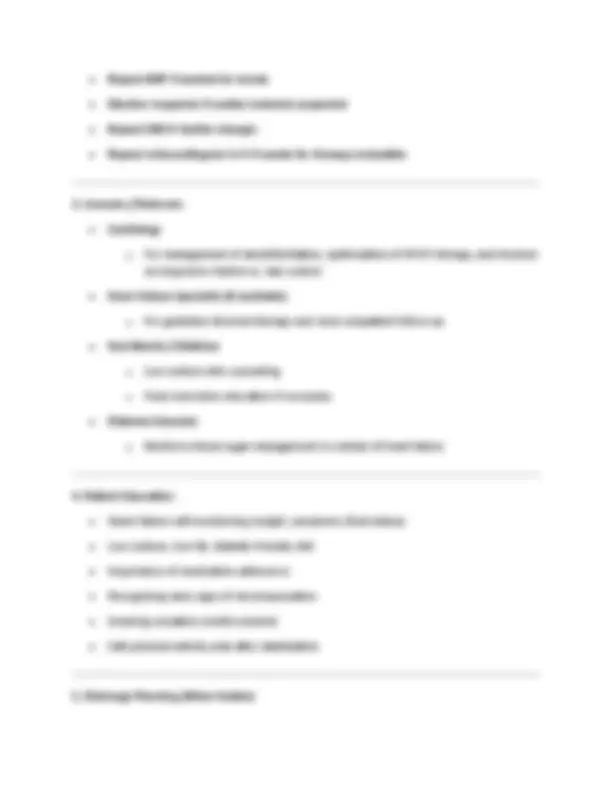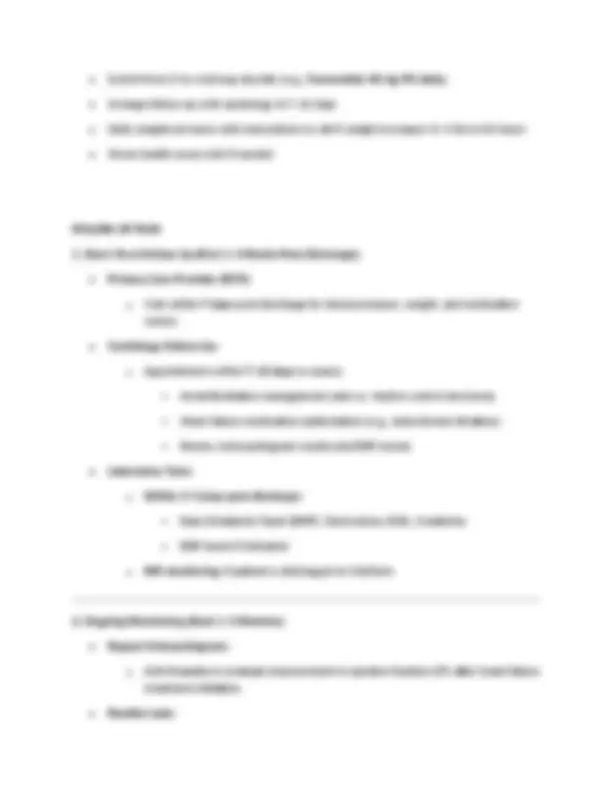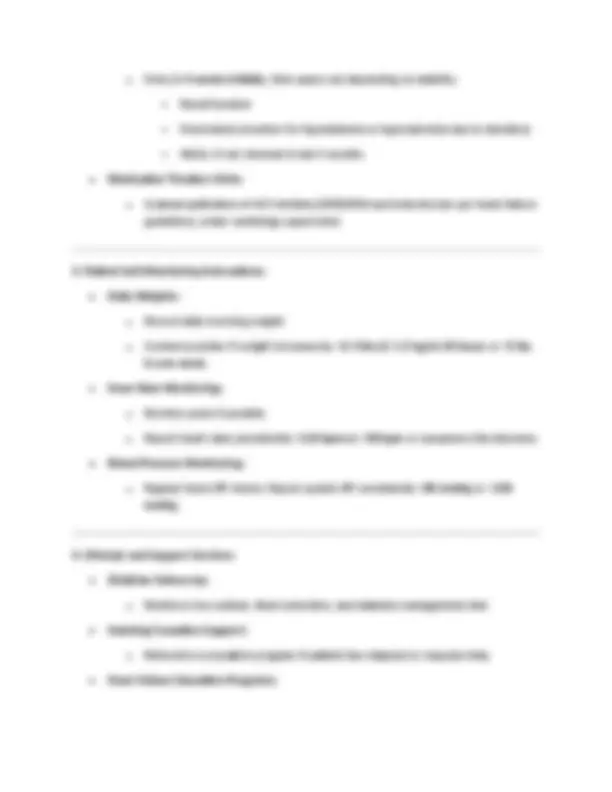Download LATEST 2025 VERIFIED I-HUMAN WEEK 7 CASE STUDY: COMPREHENSIVE EVALUATION OF DYSPNEA IN A 6 and more Study notes Nursing in PDF only on Docsity!
LATEST 2025 VERIFIED I-HUMAN WEEK 7 CASE STUDY: COMPREHENSIVE EVALUATION OF
DYSPNEA IN A 60-YEAR-OLD FEMALE PATIENT | FULL HPI, OBJECTIVE DATA, DIAGNOSIS,
MEDICATIONS, TREATMENT & FOLLOW-UP PLAN | A+ GRADED ACTUAL CASE GUIDE
2025 i-Human Week 7 Dyspnea Case: 60-Year-Old Female Patient | CHF, Atrial Fibrillation, HFrEF | Full SOAP Note, Treatment, Follow-Up Reason for Encounter (Chief Complaint): Shortness of breath worsening over the past 5 days Patient Information:
- Age: 60 years
- Gender: Female
- History: Hypertension, Type 2 Diabetes Mellitus, Former smoker Full HPI (History of Present Illness): The patient reports progressive shortness of breath over the past 5 days. Initially experienced during exertion, now occurring at rest. Denies chest pain but admits to occasional palpitations. Notes swelling in both legs and mild fatigue. Denies cough, fever, or sputum production. Past Medical History:
- Hypertension (10 years)
- Type 2 Diabetes Mellitus (5 years)
- Hyperlipidemia
- Former smoker: 20 pack-years, quit 5 years ago Medication List:
- Lisinopril
- Metformin
- Atorvastatin Objective Data: Vital Signs:
- BP: 148/92 mmHg
- HR: 98 bpm
- Monitor electrolytes, renal function
- Cardiology consultation Patient Education:
- Importance of medication adherence
- Low-sodium diet
- Daily weight monitoring
- Smoking cessation reinforcement
- Heart failure symptom monitoring PI (Past Illnesses / Past Medical History):
- Hypertension, diagnosed 10 years ago, controlled with medication (Lisinopril).
- Type 2 Diabetes Mellitus, diagnosed 5 years ago, managed with oral hypoglycemics (Metformin).
- Hyperlipidemia, under treatment with statins (Atorvastatin).
- Former smoker, with a history of 20 pack-years, quit 5 years prior to the current visit.
- No known history of coronary artery disease, chronic lung disease, or previous hospitalizations for heart failure.
- No history of chronic kidney disease or stroke.
- HPI (History of Present Illness):
- The patient is a 60-year-old female who presents with a 5-day history of progressively worsening shortness of breath. She reports that the dyspnea initially occurred only with exertion but has now progressed to occur even at rest. The patient describes it as a constant sensation of "air hunger," without sharp or pleuritic chest pain. She denies any recent upper respiratory infection symptoms, such as cough, fever, or sore throat.
- She reports associated lower extremity swelling that has worsened over the past week, particularly noticeable in the evenings. She notes feeling unusually fatigued over the last several days, limiting her ability to perform daily activities such as climbing stairs or walking short distances.
- The patient also mentions experiencing palpitations intermittently, described as an irregular, fast heartbeat without associated dizziness or syncope. She denies orthopnea or paroxysmal nocturnal dyspnea but admits she has been sleeping with two pillows for comfort.
- She has a past medical history significant for hypertension, type 2 diabetes mellitus, and hyperlipidemia. Her medications include Lisinopril, Metformin, and Atorvastatin. She has a history of smoking but quit 5 years ago after smoking approximately 20 pack-years.
- She denies any recent travel, immobilization, or known history of blood clots. She has not experienced any chest trauma.
Objective Data Vital Signs:
- Blood Pressure: 148/92 mmHg
- Heart Rate: 98 beats per minute, irregular
- Respiratory Rate: 22 breaths per minute
- Temperature: 98.6°F (37°C)
- Oxygen Saturation: 89% on room air General Appearance:
- Appears fatigued and mildly distressed due to shortness of breath
- Alert and oriented × Skin:
- No cyanosis or pallor noted
- No focal deficits
- Grossly intact Extremities:
- Bilateral pitting edema up to the knees
- No calf tenderness Diagnostics (Initial Findings):
- Chest X-ray: Cardiomegaly, pulmonary vascular congestion
- ECG: Atrial fibrillation with rapid ventricular response
- BNP: Elevated
- Echocardiogram: Reduced ejection fraction consistent with heart failure Assessment / Diagnosis Primary Diagnosis:
- Congestive Heart Failure (CHF) with Reduced Ejection Fraction (HFrEF) o Supported by: ▪ Progressive dyspnea ▪ Bilateral lower extremity edema ▪ Crackles on lung auscultation ▪ Cardiomegaly and pulmonary congestion on chest X-ray ▪ Elevated BNP
▪ Echocardiogram showing reduced ejection fraction Secondary Diagnoses / Comorbid Conditions:
- Atrial Fibrillation with Rapid Ventricular Response (RVR) o Irregularly irregular heart rhythm on exam and ECG findings o History of palpitations
- Hypertension (HTN) o Known past medical history o Elevated BP during the visit
- Type 2 Diabetes Mellitus (T2DM) o Known past medical history o Risk factor contributing to heart failure
- Hyperlipidemia o Known past medical history Differential Diagnoses Considered:
- Chronic Obstructive Pulmonary Disease (COPD) Exacerbation o Ruled out: No wheezing or history of COPD
- Pulmonary Embolism (PE) o Less likely: No history of immobilization or signs of DVT, hypoxia present but no acute chest pain
- Pneumonia o Less likely: No fever, no productive cough, clear imaging suggestive of volume overload rather than consolidation **TREATMENT PLAN
- Acute Management (Inpatient):**
- Repeat BNP if needed for trends
- Monitor troponins if cardiac ischemia suspected
- Repeat EKG if rhythm changes
- **Repeat echocardiogram in 4–6 weeks for therapy evaluation
- Consults / Referrals:**
- Cardiology o For management of atrial fibrillation, optimization of HFrEF therapy, and decision on long-term rhythm vs. rate control
- Heart Failure Specialist (if available) o For guideline-directed therapy and close outpatient follow-up
- Nutritionist / Dietician o Low-sodium diet counseling o Fluid restriction education if necessary
- Diabetes Educator o Reinforce blood sugar management in context of heart failure 4. Patient Education:
- Heart failure self-monitoring (weight, symptoms, fluid status)
- Low-sodium, low-fat, diabetic-friendly diet
- Importance of medication adherence
- Recognizing early signs of decompensation
- Smoking cessation (reinforcement)
- Safe physical activity plan after stabilization 5. Discharge Planning (When Stable):
- Switch from IV to oral loop diuretic (e.g., Furosemide 40 mg PO daily )
- Arrange follow-up with cardiology in 7–10 days
- Daily weights at home with instructions to call if weight increases >2–3 lbs in 24 hours
- Home health nurse visit if needed **FOLLOW-UP PLAN
- Short-Term Follow-Up (First 1–2 Weeks Post-Discharge):**
- Primary Care Provider (PCP): o Visit within 7 days post-discharge for blood pressure, weight, and medication review.
- Cardiology Follow-Up: o Appointment within 7 – 10 days to assess: ▪ Atrial fibrillation management (rate vs. rhythm control decisions) ▪ Heart failure medication optimization (e.g., beta-blocker titration) ▪ Review echocardiogram results and BNP trends
- Laboratory Tests: o Within 3–5 days post-discharge: ▪ Basic Metabolic Panel (BMP): Electrolytes, BUN, Creatinine ▪ BNP levels if indicated o INR monitoring if patient is discharged on Warfarin 2. Ongoing Monitoring (Next 1–3 Months):
- Repeat Echocardiogram: o At 6 – 8 weeks to evaluate improvement in ejection fraction (EF) after heart failure treatment initiation.
- Routine Labs:
o If available through the hospital or local clinic, enroll in structured heart failure education and support programs.
5. Long-Term Care Planning: - Repeat Cardiology Evaluation: o Every 3 – 6 months or sooner as needed for heart failure management. - Primary Care Check-Ups: o Every 3 months for chronic disease management: hypertension, diabetes, hyperlipidemia.

